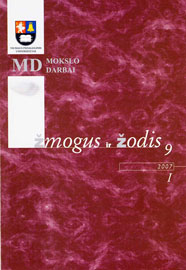Kabliataškio ir brūkšnio vartosena L Simonaitytės ir J. Ivanauskaitės tekstuose
Usage of the Semi-colon and the Dash in the Texts of L Simonaitytė and J. Ivanauskaitė
Author(s): Živilė Kuncaitė, Laimutė BučienėSubject(s): Language and Literature Studies
Published by: Vytauto Didžiojo Universitetas
Keywords: punctuation; semi-colon; dash; homogeneous parts of a sentence; attribute; apposition; parenthesis; complex asyndetic sentence.
Summary/Abstract: The aim of this article is to analyse the usage of the semi-colon and the dash in I. Simonaitytė's novel "Vilius Karalius" and J. Ivanauskaitė's novel "Fortress of the Sleeping Butterflies" and to compare it with the standard usage. The study material consists of approximately 1600 examples with the mentioned punctuation marks. The number of the semi-colons and the dashes, used in these texts, differs markedly. The absolute leader is the dash; this is because the sphere of usage of the dash is substantially wider. Semi-colon in L Simonaitytė's novel performs the function of separation of homogeneous parts or components of a sentence; it is put in order to highlight or contrast the components, separate the enumeration, group the components of sentences. Not a single semi-colon can be found in the analysed text ofthe modern times writer J. Ivanauskaitė, though sometimes, it seems, long sentences of a complex structure are asking for one or another separation of components of a sentence in parts, grouping. Both authors reasonably use the dash resources, which cover many cases of punctuation: sameness, generalization, conclusion, leap of thought, conflict and comparison, omission, emphasis of relevant elements of a sentence. Analysing the novels the dependence of the punctuation marks on the narrative style has been noticed. In L Simonaitytė's text the usage ofthe semi-colon and the dash quite often deviates from the standard punctuation due to the wish to highlight the thought.
Journal: Žmogus ir žodis
- Issue Year: 09/2007
- Issue No: 1
- Page Range: 24-30
- Page Count: 7
- Language: Lithuanian

